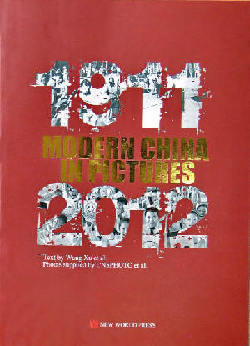Images of a Changing Nation

By LI SHUJUAN
Modern China in Pictures
Text by Wang Xu et al.
Photos supplied by CNSPHOTO et al.
345 pages, paperback
Price: RMB 78
Published by New World Press in January 2013
LI Hongzhang, called by some “the Bismarck of the East,” exhorted the Qing emperor in a letter in 1872 to embrace Western technologies and so keep abreast of the times, saying, “This will be a change unprecedented in China’s 3,000-year history.” But it was only the beginning. The 20th century saw a tide of even more dramatic and thoroughgoing changes whose impact is still apparent today. When looking back on the volatile 100 years that have passed, the question that arises is: what exactly was the course of these changes?
Modern China in Pictures tries to answer the question through 450 pictures of daily life in the Middle Kingdom from 1911 to 2012. They document changes in the life of everyday people, apparent in clothing, eating habits, housing and transportation, all of which reflect their social environment and aspirations in a society amid change.
The first photo is of the Imperial Palace, symbol of the majesty and imperial power of the empire. But the revolution that broke out on the evening of October 10, 1911, brought an end to centuries of dynastic rule in China. The Republic of China was founded in 1912, but the country was to endure secession and unrest in the lead-up to its eventual rebirth.
The focus of the first chapter, A Difficult Start (1911-1927), is on the wave of modernization that challenged every aspect of old China. Men cut off their pigtails, and the binding of women’s feet was outlawed. Trains rumbled across the countryside and steamboats chugged up and down rivers, bringing an ancient nation onto the fast track of modernization. Changes in the physical world also affected Chinese people’s outlook, manifest in progressive thought that finally triumphed in the New Culture Movement, heralding a brand-new era.
On April 18, 1927, the central government of the Republic of China was founded in Nanjing. But long-awaited stability and revitalization were still a long way off. The second chapter, Years of Crisis (1928-1949), includes a centerfold photo of railways under construction. Sun Yet-sen, pioneer of the Chinese democratic revolution, declared that transportation is the mother of the industry, and that the railway is the mother of transportation. In 1928, the Nanjing government made a large-scale plan to build railways. But it remained on the drawing board during an era of warlordism, Japanese invasion and social turmoil.
On October 1, 1949, the People’s Republic of China was founded. China’s history then took an immense turn. The third chapter, A New World (1949-1965), reflects the establishment of a new social institution that enabled the nation’s economic recovery and return to peace and stability. There were painful experiences during this period, like the Great Leap Forward that resulted in the “three-year famine,” but the country maintained its development momentum. More important, the revolution endowed dignity and rights on people at the grassroots. Department stores, cinemas and theaters, hospitals, schools and parks opened their doors to everyone, no matter how humble. People were optimistic and industrious because they were in full control of their lives. The extravagance and decadence of the old era was no more.
In 1966 the “cultural revolution” broke out. It brought disaster, apparent in turmoil and internal frictions, to the country and dealt a heavy blow to Chinese culture. The fourth chapter, Freeze-Frame of a Symbolic Era (1966-1976), shows the prevalent fanaticism, blind faith and sheer absurdities of this period. The people nevertheless maintained their pace of life, and pursuit of beauty, love and joy. Although everyone, men and women alike, dressed almost identically and had a common mode of life, it was nonetheless possible to catch a glimpse of a colorful dress. Festivals were still celebrated with fireworks and dumplings and the occasional small party. The general public thus clung on to life’s fundamental pleasures, so sustaining humanity throughout those chaotic years.
The year 1978 marked the start of a new era. The chapter Catching up with the World (1977-2001) includes a picture of people scrambling to buy newspapers that published the communiqué of the Third Plenary Session of the 11th CPC Central Committee, which heralded the reform and opening-up policy. It was then that China began its endeavors to integrate with the rest of the world. Rapid economic development gave more and more people access to wealth. Exotic foods, fashionable garments and luxurious housing became available. Resumption of the university entrance examination rebuilt faith in the concept that “knowledge is power.”
Since entering the 21st century, China, to quote the title of the last chapter, has been “merging with the world.” China’s development is irrefutable, and the “Chinese miracle” will continue unabated. The maglev high-speed railway, with a maximum speed of 430 kph, connects the vast lands of China, realizing the dream of Sun Yet-sen. Enhanced economic strength and abundant merchandise give rise to multiple and diversified choices and tastes, as well as to a vibrant and diverse social life. It is impossible to describe China and the Chinese people in words alone.
Today, the century-long dream of national rejuvenation is becoming reality. As a developing country, however, China still has a long way to go. After 30 years of reform and opening-up, certain latent conflicts and problems have become prominent in the course of pursuing the grand objective of development and prosperity. Hope for the future and anxiety about potential risks coexist. People are calling for equality, justice and harmony. Growing numbers of Chinese people devote themselves to charity work for purposes of self-fulfillment and sharing what they have. An even more vital and confident society will undoubtedly appear in China.

